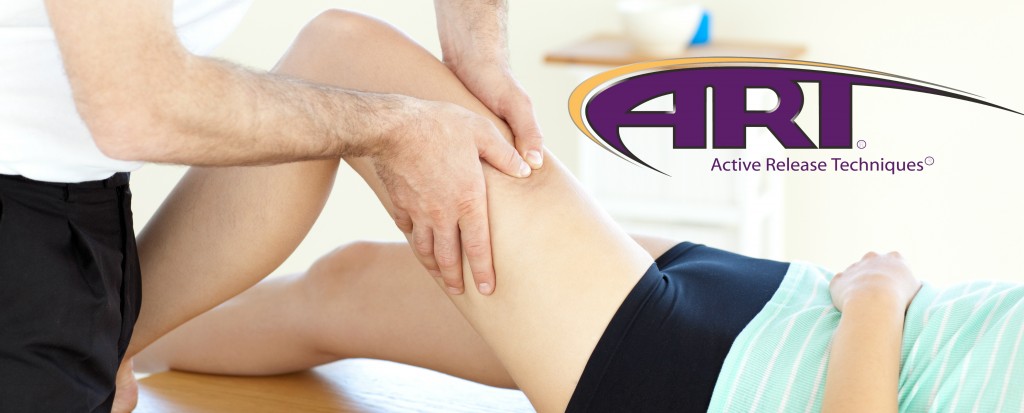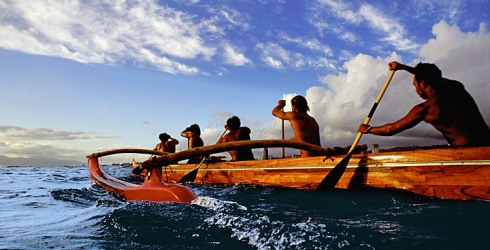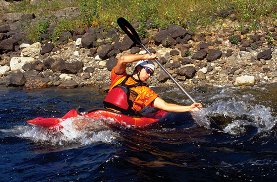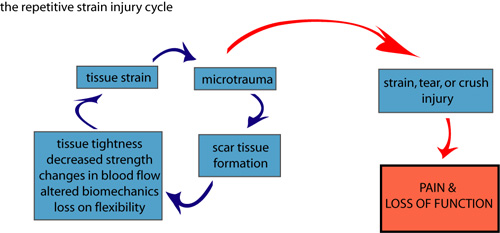Resolving Paddling Injuries With Active Release Techniques (ART)
As any athlete knows, there is nothing worse than being unable to perform your best because of pain and injury. Unfortunately, injuries are a common occurrence in paddling sports such as canoeing, kayaking, rowing, and dragon boat racing. To make matters worse, these injuries are often slow to respond to traditional types of care, keeping paddlers sidelined for weeks, and sometimes months at a time. Now for the good news – a new treatment technique known as Active Release Techniques® (ART® ) is proving to be a very effective treatment method to address many common paddling injuries and is helping athletes get back on the water quickly and effectively. But before we talk about why ART® works so effectively, you first need to understand how paddling injuries occur in the first place.
Why are Paddling Injuries so Common?
It is important to realize that there are two basic types of injuries – acute and repetitive. Acute injuries occur following a trauma, such as a fall or major collision. Repetitive injuries, like the name implies, occur slowly over time as a result of performing the same motions over and over again. Although acute injuries are uncommon in paddling sports, repetitive injuries occur very frequently. When looking at the demands of paddling sports – whether it is kayaking, canoeing, rowing, or dragon boat racing – you can see that each event requires the athlete to perform the same stroking or paddling motion again and again. Over the course of a race or training session, the number of paddle strokes that the athlete is required to perform can quickly add up to hundreds and even thousands or strokes. The repetitive motion of paddling is bad enough, but each paddling stroke also requires the body to generate a significant amount of force to propel the boat forward in the water. This force is generated and then transferred through the entire body, as the mechanics of the various paddling sports requires the muscles and joints to work together in an integrated manner. This concept of integration is referred to as the kinetic chain. For example, with canoeing and dragon boat racing, the athlete paddles in a kneeling position. With each stroke the paddler generates a force that is transmitted to the water through the paddle. The resultant reaction force from the water is then transferred back through the paddle to the arms and shoulders of the athlete, down the trunk, through the hips to the knees and foot, and finally to the boat, causing the boat to be propelled forward. With kayaking and rowing the athlete is in a different position but this concept of the kinetic chain and the need to have proper force transfer between the boat, body, paddle, and water is the same. As a result of this interconnectedness, the repetitive forces associated with paddling can lead to injury in a number of muscles and joints – most commonly the forearm, shoulder, back, and hip. When the athlete has adequate strength, flexibility, and muscle balance along the entire kinetic chain the chances of injury are greatly reduced, however, as you will see, even minor imbalances can create major problems.
How Do Paddling Injuries Occur?
If even a minor problem exists in the strength, flexibility, or coordination of just one muscle or joint, it will not only lead to a problem at that specific area, but it will also cause the body to move in an unwanted and inefficient manner in an effort to compensate for the problem. These alterations in body movements are referred to as “movement compensations”. Movement compensations are very common, but on their own and with normal daily activities these problems in the muscles and joints often do not cause create significant issues. However, because of the high force, repetitive movements associated with paddling, even minor movement problems will be greatly magnified and will prevent the paddler from properly generating and controlling the forces associated with each stroke. As this occurs, instead of the muscle forces being generated and transferred effectively through the muscles and joints of the kinetic chain, the forces become concentrated at a particular area, usually the area of the movement compensation. As a result of the impact that movement compensations have on the paddling stroke and the association between movement compensations and paddling injuries, it is critical that the entire kinetic chain is evaluated to ensure all areas are functioning properly, not just the area of pain. Failure to identify and correct these compensations will not only prolong the injury process, but will also lead to the injury re-occurring over and over again as the underlying cause of the problem is not dealt with.
The Injury Process
From the preceding information it should be clear that paddling is a highly repetitive activity that is associated with a tremendous amount of muscular force. Over time these repetitive forces can accumulate in the body, leading to strain and dysfunction of the muscles, ligaments, and joints. Although the presence of movement restrictions and compensations will greatly magnify this process, even the paddler with optimal technique will be subject to this strain accumulation simply due to the high force, high repetition demands of paddling. As time goes on and the paddler continues to train and compete, the strain will develop into micro-trauma. Initially this microtrauma is not painful, but may be perceived as a mild ache or tightness in the muscles or joints. Although only small, this damage still needs to be repaired. The body responds to tissue injury in a very predictable way – by laying down new tissue to repair the damaged area. With micro-trauma the body repairs the strained tissue by laying down small amounts of scar tissue in and around the injured area. The scar tissue itself is not a problem; in fact, it is a normal and necessary part of healing. The problem occurs when the body is subjected to the same repetitive forces of paddling over and over again. This in turn causes the same muscles to become strained and subsequently repaired over and over again. Over time this scar tissue will build-up and accumulate into what are called adhesions. As these adhesions form they start to affect the normal health and function of the muscles. In fact, they will often lead to pain, tightness, stiffness, restricted joint motion, and diminished blood flow.
As scar tissue adhesions accumulate, it places more and more strain on the muscles and joints of the kinetic chain as they must now stretch and contract against these adhesions with each stroke. This places even further strain on the body, which in turn leads to more micro-trauma. Essentially a repetitive injury cycle is set-up causing continued adhesion formation and progressive movement dysfunction. As the cycle progresses the ability of the muscles to contract properly is diminished, compromising the body’s ability to generate and transfer forces along the kinetic chain. At this point it is not uncommon for the muscles to give way and for a more severe to pain. In fact many paddlers come into our office explaining how they have had an injury but have not done anything different that may have caused the pain. When further questioned these paddlers almost always describe some mild pain or tightness that has been building over time. As you can see from the explanation of the repetitive injury cycle, these types of injuries build-up over time and the more acute injury is often just the “straw-that-broke-the-camels-back.”
How Can Paddling Injuries Be Fixed?
The Traditional Approach…
In an attempt to treat paddling injuries, a variety of treatment methods are used, either on their own, or in combination with other methods. Some of the more common approaches include anti-inflammatory medications, rest, ice, ultrasound (US), muscle stimulation (E-Stim), steroid injections, stretching, exercise, and when all else fails, surgery. Unfortunately, most of these traditional techniques generally require a long period of time before they provide any significant relief, and in many cases provide only temporary relief from symptoms instead of fixing the underlying cause of the problem. This can be a huge problem as paddlers often want and need to get back to training and competition as soon as possible. The main reason that these approaches are often ineffective is that they fail to address the underlying scar tissue adhesions that develop within the muscles and surrounding soft tissues. It is these adhesions that are binding the tissues together, restricting normal movements, and interfering with the normal flexibility and contraction of the muscles in the kinetic chain. Passive approaches such as medications, rest, ice, and steroid injections all focus on symptomatic relief and do nothing to address the muscle restrictions and movement compensations. More active approaches such as stretching and exercises are often needed for full correction of the condition and to restore full strength and function of the muscles; however, they themselves do not treat the underlying adhesions. In fact, without first addressing the scar tissue adhesions, stretches and exercises are often less effective and much slower to produce relief or recovery from paddling injuries.
Active Release Techniques® Our Approach: ART® – A Better Solution
ART stands for Active Release Technique. It is a new and highly successful hands-on treatment method to address problems in the soft tissues of the body, including the muscles, ligaments, fascia, and nerves. ART* treatment is highly successful in dealing with paddling related injuries because it is specifically designed to locate and treat scar tissue adhesions that accumulate in the muscles and surrounding soft tissues. By locating and treating the soft-tissue adhesions with ART*, it allows the practitioner to, 1) break-up restrictive adhesions, 2) reinstate normal tissue flexibility and movement, and 3) more completely restore flexibility, balance, and stability to the injured area and to the entire kinetic chain.

You can think of an ART* treatment as a type of active massage. The practitioner will first shorten the muscle, tendon, or ligament, and then apply a very specific pressure with their hands as you actively stretch and lengthen the tissues. As the tissue lengthens the practitioner is able to assess the texture and tension of the muscle to determine if the tissue is healthy or contains scar tissue that needs further treatment. When scar tissue adhesions are felt the amount and direction of tension can be modified to treat the problematic area. In this sense, each treatment is also an assessment of the health of the area as we are able to feel specifically where the problem is occurring.
An additional benefit of ART is it allows us to further assess and correct problems not only at the site of pain itself, but also in other areas of the kinetic chain, which are associated with movement compensations and are often contributing factors to the problem. This ensures that all the soft tissues that have become dysfunctional and are contributing to the specific injury are addressed, even if they have not yet all developed pain. One of the best things about ART is how fast it can get results. In our experience, the majority of paddling related injuries respond very well to ART* treatment, especially when combined with the appropriate home stretching and strengthening exercises. Although each case is unique and there are several factors that will determine the length of time required to fully resolve each condition, we usually find a significant improvement can be gained in just 4 – 6 treatments. These results are the main reason that many elite athletes and professional sports teams have ART practitioners on staff, and why ART is an integral part of the Iron man triathlon series. To book an appointment to see if ART will be able to help with your paddling related injury, simply call our office at 613.237.3306 or fax 613.237.3100




